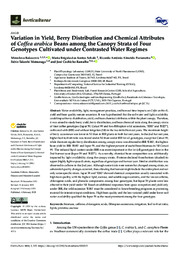Variation in Yield, Berry Distribution and Chemical Attributes of Coffea arabica Beans among the Canopy Strata of Four Genotypes Cultivated under Contrasted Water Regimes
Variation in Yield, Berry Distribution and Chemical Attributes of Coffea arabica Beans among the Canopy Strata of Four Genotypes Cultivated under Contrasted Water Regimes
Autoria: RAKOCEVIC, M.; SCHOLZ, M. B. dos S.; PAZIANOTTO, R. A. A.; MATSUNAGA, F. T.; RAMALHO, J. C.
Resumo: Abstract: Water availability, light, management practices, and harvest time impacts on Coffea arabica L. yield and bean quality remain uncertain. It was hypothesized that the soil water and light availability could impact berry distribution, yield, and bean chemical attributes within the plant canopy. Therefore, it was aimed to study berry yield, berry distribution, and bean chemical traits along the canopy strata of four coffee genotypes (Iapar 59, Catuaí 99 and two Ethiopian wild accessions, ?E083? and ?E027?), cultivated with (IRR) and without irrigation (NI) in the two initial harvest years. The maximum height of berry occurrence was lower in NI than in IRR plants in both harvest years. In the 2nd harvest year, higher leaf-to-fruit ratio was found under NI than under IRR for all genotypes, except for Catuaí 99, while the most regular berry distribution among canopy strata was obtained in IRR ?E083?, the highest bean yield in IRR ?E083? and Iapar 59, and the highest percent of useful bean biomass in NI Catuaí 99. The reduced lipid content under IRR was more important in the 1st (all genotypes) than in the 2nd harvest year (Iapar 59 and ?E027?). As a novelty, chemical bean composition was additionally impacted by light availability along the canopy strata. Proteins declined from bottom (shaded) to upper (highly light exposed) strata, regardless of genotype and harvest year. Similar stratification was observed in caffeine in the 2nd year. Although some traits were somewhat changed among strata, no substantial quality changes occurred, thus allowing that harvest might include the entire plant and not only some specific strata. Iapar 59 and ?E083? showed chemical composition usually associated with high bean quality, with the highest lipid, sucrose, and soluble sugar contents, and the lowest caffeine, chlorogenic acids, and phenolic components among four genotypes, but Iapar 59 plants were less affected in their yield under NI. Based on additional responses from space occupation and yield only under IRR, the wild accession ?E083? must be considered in future breeding programs as promising material for intensive input conditions. High bean quality and the less variated yield under lower soil water availability qualified the Iapar 59 as the most prominent among the four genotypes.
Ano de publicação: 2023
Tipo de publicação: Artigo de periódico
Unidade: Embrapa Meio Ambiente
Observações
1 - Por padrão são exibidas publicações dos últimos 20 anos. Para encontrar publicações mais antigas, configure o filtro ano de publicação, colocando o ano a partir do qual você deseja encontrar publicações. O filtro está na coluna da esquerda na busca acima.
2 - Para ler algumas publicações da Embrapa (apenas as que estão em formato ePub), é necessário ter, no celular ou computador, um desses softwares gratuitos. Sistemas Android: Google Play Livros; IOS: iBooks; Windows e Linux: software Calibre.
Acesse outras publicações
Acesse a Base de Dados da Pesquisa Agropecuária (BDPA) para consultar o acervo completo das bibliotecas da Embrapa.

